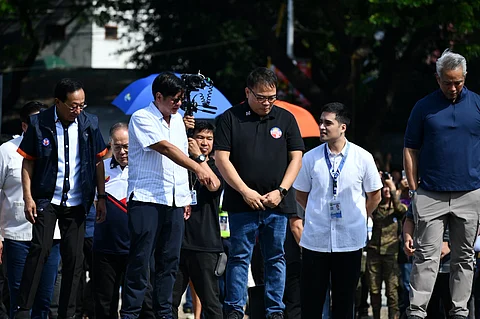
- NEWS
- the EDIT
- COMMENTARY
- BUSINESS
- LIFE
- SHOW
- ACTION
- GLOBAL GOALS
- SNAPS
- DYARYO TIRADA
- MORE

President Ferdinand Marcos Jr. led the launch of the Metropolitan Manila Development Authority’s (MMDA) Bayanihan sa Estero Program, which aims to step up efforts to clean and maintain the drainage infrastructure across the metropolis, as heavily silted and garbage-choked waterways continue to worsen flooding during the rainy season.
Metro Manila's drainage system includes 273 identified rivers, tributaries, esteros, and open canals that serve as primary channels for stormwater and flood runoff.
The program is being implemented in coordination with key stakeholders, including local governments, national agencies, and civil society organizations.
MMDA Chairman Atty. Don Artes said the Bayanihan sa Estero Program is the agency’s response to the President’s socioeconomic agenda of strengthening disaster resilience.
He emphasized the importance of clearing waterways to reduce the impact of floods triggered by increasingly severe rainfall—an effect of climate change, which the President has called the “new normal.” Artes attributed the problem of clogged esteros to worsening public discipline in waste disposal.
“Our initiatives play a vital role in flood mitigation. We need to intensify these efforts of declogging our drainage laterals, dredging of open waterways, desilting of drainage mains, and removal of accumulated solid waste with the help of our stakeholders,” he said.
Artes said the Bayanihan sa Estero Program represents collective action—especially critical during the rainy season and storms—and is a reminder of the bayanihan spirit: “from esteros to barangays, from government to houses,” he said, adding that unity is key to achieving real change.
He also noted that the MMDA now owns and administers its new desilting equipment, rather than contracting the work out.
The program targets 23 priority esteros that need immediate intervention due to high siltation, solid waste accumulation, poor flow conditions, and frequent flooding.
Of the 23 waterways, 12 have already undergone extensive cleanup, with 881 cubic meters of garbage removed. The remaining 11 are scheduled for cleanup, with coordination ongoing between the MMDA and local governments.
